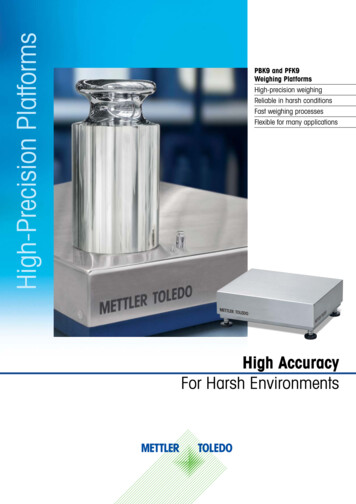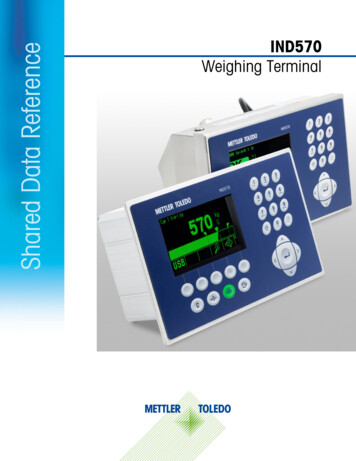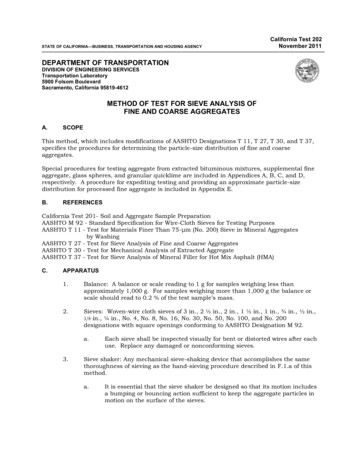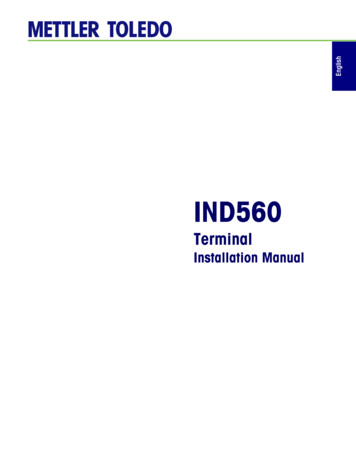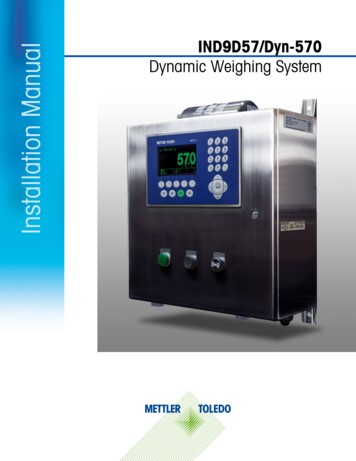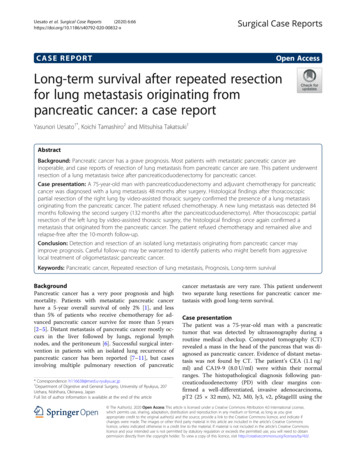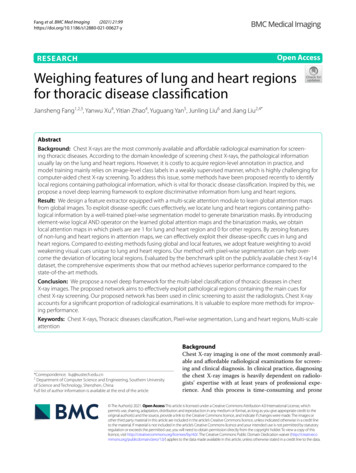
Transcription
(2021) 21:99Fang et al. BMC Med pen AccessRESEARCHWeighing features of lung and heart regionsfor thoracic disease classificationJiansheng Fang1,2,3, Yanwu Xu4, Yitian Zhao4, Yuguang Yan5, Junling Liu6 and Jiang Liu2,4*AbstractBackground: Chest X-rays are the most commonly available and affordable radiological examination for screening thoracic diseases. According to the domain knowledge of screening chest X-rays, the pathological informationusually lay on the lung and heart regions. However, it is costly to acquire region-level annotation in practice, andmodel training mainly relies on image-level class labels in a weakly supervised manner, which is highly challenging forcomputer-aided chest X-ray screening. To address this issue, some methods have been proposed recently to identifylocal regions containing pathological information, which is vital for thoracic disease classification. Inspired by this, wepropose a novel deep learning framework to explore discriminative information from lung and heart regions.Result: We design a feature extractor equipped with a multi-scale attention module to learn global attention mapsfrom global images. To exploit disease-specific cues effectively, we locate lung and heart regions containing pathological information by a well-trained pixel-wise segmentation model to generate binarization masks. By introducingelement-wise logical AND operator on the learned global attention maps and the binarization masks, we obtainlocal attention maps in which pixels are are 1 for lung and heart region and 0 for other regions. By zeroing featuresof non-lung and heart regions in attention maps, we can effectively exploit their disease-specific cues in lung andheart regions. Compared to existing methods fusing global and local features, we adopt feature weighting to avoidweakening visual cues unique to lung and heart regions. Our method with pixel-wise segmentation can help overcome the deviation of locating local regions. Evaluated by the benchmark split on the publicly available chest X-ray14dataset, the comprehensive experiments show that our method achieves superior performance compared to thestate-of-the-art methods.Conclusion: We propose a novel deep framework for the multi-label classification of thoracic diseases in chestX-ray images. The proposed network aims to effectively exploit pathological regions containing the main cues forchest X-ray screening. Our proposed network has been used in clinic screening to assist the radiologists. Chest X-rayaccounts for a significant proportion of radiological examinations. It is valuable to explore more methods for improving performance.Keywords: Chest X-rays, Thoracic diseases classification, Pixel-wise segmentation, Lung and heart regions, Multi-scaleattention*Correspondence: liuj@sustech.edu.cn2Department of Computer Science and Engineering, Southern Universityof Science and Technology, Shenzhen, ChinaFull list of author information is available at the end of the articleBackgroundChest X-ray imaging is one of the most commonly available and affordable radiological examinations for screening and clinical diagnosis. In clinical practice, diagnosingthe chest X-ray images is heavily dependent on radiologists’ expertise with at least years of professional experience. And this process is time-consuming and prone The Author(s) 2021. Open Access This article is licensed under a Creative Commons Attribution 4.0 International License, whichpermits use, sharing, adaptation, distribution and reproduction in any medium or format, as long as you give appropriate credit to theoriginal author(s) and the source, provide a link to the Creative Commons licence, and indicate if changes were made. The images orother third party material in this article are included in the article’s Creative Commons licence, unless indicated otherwise in a credit lineto the material. If material is not included in the article’s Creative Commons licence and your intended use is not permitted by statutoryregulation or exceeds the permitted use, you will need to obtain permission directly from the copyright holder. To view a copy of thislicence, visit http:// creat iveco mmons. org/ licen ses/ by/4. 0/. The Creative Commons Public Domain Dedication waiver (http:// creat iveco mmons. org/ publi cdoma in/ zero/1. 0/) applies to the data made available in this article, unless otherwise stated in a credit line to the data.
Fang et al. BMC Med Imaging(2021) 21:99Page 2 of 12Fig. 1 Examples demonstrating pathological regions of eight thoracic diseases of chest X-rays. Predicted bounding boxes by our method areshown in blue and ground truth in redto subjective assessment errors [1]. Hence, it is stronglydesired to develop a computer-aided diagnosis systemto support clinical practitioners. Many existing worksusing deep learning have been proposed to automatically diagnose thoracic diseases for chest X-ray imagesin recent years and achieve remarkable progress, such asdisease classification [2, 3], abnormality detection [4, 5],chest X-ray segmentation [6, 7], disease prediction [8, 9].Among various computer-aided diagnosis tasks for chestX-ray images, our work aims to address the disease classification task. The classification task is highly challengingfor computer-aided screening due to the low resolutionand poor specificity of chest X-ray images.Early works using convolutional neural networks(CNN) [10–12] for thoracic disease classification of chestX-ray images typically employ the global image for modeltraining. However, the global learning strategy may sufferfrom the affection of normal regions. As shown in Fig. 1,each image contains two parts: pathological regions(red bounding box) and normal regions. The pathological regions are the main cues for screening chest X-ray,and its cues may be drowned in the global image duringmodel learning due to the affection of normal regions. Forexample, the nodule occupies a small area, and its visualcues are difficult to be reserved in the ultimate featuresdue to a large number of convolution layers that reducethe detail characteristics. Considering this fact, it is vitalto enhance the visual features of pathological regions andsuppress the disturbing of normal regions during modeltraining. However, although several large chest X-raydatasets [13–15] have been published, region-level annotations are still scarce and expensive to acquire. Withimage-level annotations (class labels), some strategiesrelated to pathological region locating and learning havebeen explored in many existing methods [16, 17].The performance of region learning heavily relies onthe accuracy of locating pathological regions with classlabels. Some existing methods have been proposed tolocate pathological regions for thoracic disease classification in chest X-rays, such as region proposals [18, 19],saliency maps [18, 19]. However, without region-levelannotations, they cannot precisely identify pathological regions by predicting bounding box, as shown in theblue rectangle of nodule image of Fig. 1. According tothe report of existing works [17] on the chest X-ray14dataset [20], the best performance of predicting bounding box is 0.29 average intersection over union (IoU) and0.37 average continuous Dice. To avoid the deviation oflocating pathological regions, some works [16, 21] proposed the deep fusion network by integrating the globalfeatures to compensate the lost discriminative curesof local features. However, the fusion methods must becareful tuned to avoid the local features smoothing outin the global features. The local features have learned
Fang et al. BMC Med Imaging(2021) 21:99pathological information, but its differentiating role willbe weakened on the fusion process. Considering theabove issues, our work designs a novel deep learningframework to explore discriminative information fromlocal regions and enhance the differentiating role of localregions for thoracic disease classification.By observing the area of pathological regions in Fig. 1,the domain knowledge that pathological regions of thoracic diseases are typically limited within the lung andheart can be asserted. Inspired by this prior knowledge,we can locate lung and heart regions by pixel-wise segmentation. Although the lung and heart regions still contain non-pathological regions that occupy large areas,these areas are smaller than the entire image and effectively cover pathological information. In fact, our methodmakes a trade-off between suppressing normal regionsand identifying pathological regions accurately. Based onthe global attention maps, the local features of the lungand heart regions are uniquely used for class-probabilityprediction by applying pixel-wise segmentation. Withoutregion-level annotations, it is difficult to locate pathological regions accurately; our solution is to make themost efforts to narrow the regions containing pathological information. The main contributions of this work aresummarized as follows:1. To effectively learn the discriminative informationfrom pathological regions and avoid the affectionof normal regions, we propose a novel deep learning framework for thoracic diseases classification inchest X-ray. The proposed framework combines afeature extractor equipped with a multi-scale attention module and a well-trained pixel-level segmentation model for the lung and heart regions.2. The multi-scale attention module learns the discriminative information from chest X-ray images to generate global attention maps. We apply a feature weighting strategy for the lung and heart regions containingpathological information to exploit their disease-specific cues effectively.3. Evaluated by the benchmark split on the publiclyavailable chest X-ray14 dataset, the comprehensiveexperiments show that our method can achieve thebest performance compared to the state-of-the-artmethods. The multi-scale attention module can beembedded into any off-the-shelf networks to helppromote the classification performance.Related worksChest X-ray datasets. Chest X-ray imaging is one of themost widely available modalities to assess thoracic diseases. And for a long time, the task of computer-aidedPage 3 of 12screening for chest X-ray images has been extensivelyexplored in the field of medical image analysis. Several released hospital-scale chest X-ray datasets greatlyfoster multi-label classification research of thoracicdiseases and especially benefits the data-hungry deeplearning model. For example, the MIMIC-CXR dataset [13] contains 377, 110 chest X-rays associated with14 labels, the Chexpert dataset [14] provides 224, 316chest X-rays associated with 14 labels, the PadChestdataset [15] includes more than 160, 000 images labeledwith 19 differential diagnoses. Among the larger publicly available chest X-ray datasets, the Chest X-ray14dataset [20] attracts more research due to its earlierpublish and higher quality and has been establishedstrong baselines [16, 17]. Due to the comparable strongbaselines, we adopt this dataset to demonstrate theadvantage of our proposed method. To automaticallyextract the lung and heart regions from the globalimages, we use the JSRT dataset [22] to train the lungand heart segmentation model. It provides 154 nodule and 93 non-nodule chest X-ray images. A detaileddelineation of the segmentation’s nodule is publiclyavailable to train the lung, and heart segmentation[23]. The annotation images for segmentation tasksare binary images in which pixels are 255 for the foreground and 0 for the background.Attention mechanisms for medical image analysis.Recently, attention mechanisms applied in CNN can significantly enhance the performance of various tasks inthe field of medical image analysis [24–26]. For instance,A novel Attention Gate (AG) [27] can be easily integratedinto standard CNN models to leverage salient regionsin medical images for various medical image analysistasks, including fetal ultrasound classification and 3Dcomputed tomography (CT) abdominal segmentation.Attention mechanisms can help detect subtle differencesbetween different diseases by guiding the model activations to focus on salient regions. This feature is particularly suitable for analyzing chest X-ray images due to thelow resolution and poor specificity of chest X-ray images[28, 29]. For example, a contrast-induced attention network [30] is proposed to exploits the highly structuredproperty of chest X-ray images and localizes diseases viacontrastive learning on the aligned positive and negative samples. For the multi-label classification problemof thoracic diseases, an attention-guided mask inference process is designed to locate salient regions andlearn the discriminative feature for classification [16].Inspired by this work, we improve the spatial-attentionmodule in CBAM [31] to design a multi-scale attention module, which helps explore discriminative cues toadvance the classification performance by detecting subtle differences.
Fang et al. BMC Med Imaging(2021) 21:99Local Learning for chest X-ray classification. Due to therelative scarcity of region-level annotations, local localization and learning are gaining increasing attention inthe field of chest X-ray image analysis [32, 33]. A thoracicdisease is highly characterized by a pathological region,which contains critical cues for classification. With onlyimage-level class labels, previous works [2, 10, 11] forthoracic disease classification typically learn the discriminative information from the global image by supervisedtraining. However, it is prone to be affected by normalregions. To address the problems caused by merely relying on the global image, recent approaches have shiftedto learn the discriminative information from localregions containing pathological information. For example, a deep learning framework (SENet) [12] equippedwith the squeeze-and-excitation block [34] reinforcesthe sensitivity to subtle differences between normal andpathological regions by explicitly modeling the channelinterdependence. More methods for local location rely onsaliency maps or saliency maps [17–19]. For instance, inSalNet [17], the Gumbel-softmax function [35] is used tocombine the region proposal and saliency map detectorto sample discrete regions from a set of proposed regionsdifferentially. However, without region-level annotations,they cannot precisely identify pathological regions byselecting local regions.To avoid discriminative information loss in locationdeviation of pathological regions, some methods fuse theglobal image training and the local region learning. Thedeep fusion network unifying global and local features isgradually popular in computer vision tasks [36, 37]. Forthoracic disease classification in chest X-ray images, therepresentative work of fusion methods are the segmentation-based deep fusion network (SDFN) [21] and thethree-branch attention-guided network (AGCNN) [16].In SDFN, a global classifier is used as feature extractorsto obtain the discriminative features from the entire chestX-ray image, and the cropped lung regions generated bythe segmentation model are learned by a local classifier.The obtained features from the global and local classifiersare fused by the feature fusion module for disease classification. Our method and SDFN all use the JSRT dataset[23] to train a pixel-wise segmentation model. However,the fusion methods must be careful tuned to prevent thelocal features containing pathological information fromdrowning in the global features. Hence, we apply featureweighting but not fusion to enhance visual cues uniqueto the lung and heart regions based on the learned globalattention maps and the segmented masks.Based on the above discussion of related works, ourproposed method has two novel folds: (1) a featureextractor equipped with the multi-scale attention module is used to learn the global discriminative information;Page 4 of 12(2) feature weighting strategy is applied to enhance features of the lung and heart region containing pathologicalinformation. Extensive experiments on the chest X-ray14dataset demonstrate the effectiveness of our method.MethodsBased on image-level class labels, our method is proposed to address the multi-label classification of thoracicdiseases by learning the discriminative information fromchest X-ray images effectively. This section will elaborateon our method, including the problem statement, featureextractor, feature weighting.Problem statementThoracic disease classification is a multi-label classification problem that detects if one or multiple diseasesare presented in each chest X-ray image. We define a14-dimensional label vector Y {y1 , . . . , yi , . . . , yc } foreach image, where c 14 and yi {0, 1}. yi indicates thepresence with respect to corresponding diseases in theimage (i.e. 1 for presence and 0 for absence) and an allzero vector of 14-dimensions represents the status of “NoFinding” (no disease is found in the scope of any of 14disease categories as listed). The diseases in Y are in theorder of Atelectasis, Cardiomegaly, Effusion, Infiltration,Mass, Nodule, Pneumonia, Pneumothorax, Consolidation, Edema, Emphysema, Fibrosis, Pleural Thickening,and Hernia. We address this classification problem bytraining our classification model presented in Fig. 2 withthe binary cross-entropy (BCE) loss function defined inEq 1.1[yi log(yˆi ) (1 yi ) log(1 yˆi )],ccBCE(Y , Ŷ ) i 1(1)where c is the number of diseases (classes), Y is theground truth, and Ŷ denotes the predicted probability.Our proposed deep framework covers three parts: afeature extractor, a pixel-wise segmentation model, anda feature weighting module. The feature extractor is toembed the global discriminative information into a globalattention map by applying a multi-scale attention module. The multi-scale attention module helps the featureextractor to focus on salient regions and detect subtletexture abnormality. Simultaneously, the well-trainedpixel segmentation model identifies areas of the lung andheart, following binarized as a global mask in which pixels are 1 for lung and heart region and 0 for other regions.Then we conduct an element-wise summation operation on the global attention map and the global maskto generate a local attention map. By weighing the lungand heart region features, the local attention map onlycontains visual cues unique to the lung and heart region
Fang et al. BMC Med Imaging(2021) 21:99Page 5 of 12Fig. 2 The framework of our proposed method. A feature extractor equipped with a multi-scale attention module aims to learn the discriminativeinformation from a chest X-ray image to generate a global attention map. A well-trained pixel segmentation model locates the lung and heartregions to binarize a mask in which pixels are 1 for lung and heart regions and 0 for other regions. A local attention map focusing on the lung andheart regions is formed by introducing a logical AND operator on the mask and the global attention map. This local attention map contains featuresof the pathological region and suppresses the normal regioncontaining pathological information and discards features of non-lung and heart regions by zeroing operation.Following the local attention map, an average poolinglayer and a fully-connected layer are introduced to traindisease-specific probability by binary cross-entropy loss.Feature extractorThe feature extractor consists of a multi-scale attention module and a backbone. Each chest X-ray imageX is resized into 3 224 224 and firstly inputted intothe multi-scale attention module. The multi-scale attention module computes a spatial feature hierarchy consisting of two convolutional layers with a kernel step of2 and three blocks of calculating maximum and averageacross channels. The spatial feature hierarchy is convoluted into a feature map of 1 224 224 dimension andmerged into the global image by element-wise multiplication. Based on this operation, the global image element is spatially weighted by computing the maximumvalue at different scales. The multi-scale spatial attentionmodule can detect subtle differences at different scales.Hence, it can enhance the multi-label classification performance by exploiting the visual cues effectively. Aftera sigmoid activation function, the feature map is mergedinto the original chest X-ray image by element-wise multiplication, following fed into the backbone. We use thepre-trained 121-layer DenseNet [38] as the backbone. Wetake out the last convolutional feature map from backbone as a global attention map Fg with c h w dimensions. The global attention map learns the discriminativeinformation from the chest X-ray image. The diseasespecific feature may be drowned in global features andcan not play a differentiating role in classification.Feature weightingWe apply U-Net [39] to train a segmentation model forthe left lung, right lung, and heart on the JSRT dataset byusing dice loss. The dice loss is formulated as:2 Mgt Mprob dice ,(2)( Mgt Mprob )where Mgt denotes the ground truth mask, and Mprob isthe predicted mask. The dice loss is minimized for optimization and the model with the smallest loss was saved.The image pre-processing of U-Net follows the samepipeline of the feature extractor to enable automaticregion segmentation for the chest X-ray14 dataset. We
Fang et al. BMC Med Imaging(2021) 21:99Page 6 of 12first input the chest X-ray image X into the well-trainedsegmentation model to generate three pixel-wise masksfor the left lung, right lung, and heart. Then we mergethe three pixel-wise masks into a pixel-wise mask Mg inwhich pixels are either 1 for the lung and heart regions or0 for other regions by pixel-wise summation. The pixelwise mask Mg further is resized into a size of 1 h wequal to the width and height of the global attentionmap Fg by adaptive average pooling. The global attentionmap Fg of c h w is taken out from the backbone ofthe image classifier. Further, we generate a local attention map Fl of c h w from the global attention mapand the pixel-wise mask by element-wise multiplication.We introduce the logical AND operator on the globalattention map and the pixel-wise mask. The local attention map contains the zero pixels of non-lung and heartregions and the non-zero pixels of the lung and heartregions. Hence, only the pixel values of the lung andheart region containing pathological information in thelocal attention map are embedded into the average pooling layer for label prediction by a channel-wise averageoperation, and the pixel values of other regions in theattention map are zeroed. The feature weighting for theglobal attention map Fg and the pixel-wise mask Mg isdefined as:Fl Fg Mg .(3)With the help of the multi-scale attention module, theglobal attention map effectively learns the salient information from the chest X-ray image, containing the discriminative information in the lung and heart. Thepathological regions are typically located in the lungand heart, hence, we introduce the binary masks on theglobal attention map to generate the local attention map.The generated local attention map suppresses the information of other regions and remains the information ofthe lung and heart regions. By logical AND operation, welocate features of the lung and heart regions containingpathological information.Experimental setupsIn order to test the performance of our proposed framework, we conduct extensive experiments on the publicchest X-ray14 dataset to verify the effectiveness of ourmethod. In this section, we will describe the experimental details.Chest X-ray14 dataset consists of 112, 120 frontalview X-ray images of 30, 805 unique patients [20].Each image is labeled with one or multiple classes of 14common thoracic disease: Atelectasis, Cardiomegaly,Effusion, Infiltration, Mass, Nodule, Pneumonia, Pneumothorax, Consolidation, Edema, Emphysema, Fibrosis, Pleural Thickening, and Hernia. Besides, the datasetTable 1 The statistics of the benchmark split on the ChestX-ray14 14350Pleural thickening224211430Hernia141860Multi-label totals53,97027,206984Finding36,02415,735984No finding50,50098610Totals86,52425,596984also contains 984 labeled bounding boxes for 880 imagesrelated to 8 different diseases by board-certified radiologists. In our experiments, we use disease labels asground-truth for model training. At the same time, weutilize the bounding boxes for qualitative observationof pathological region localization on chest X-rays. AsTable 1 shows, the benchmark split of this dataset [20]contains train set of 86, 524 images for model training,test set of 25, 596 images for model evaluation, and boxset of 984 images for model visualization. We randomlyselect 10% of each disease in the train set as the validation set for model validation. There is no patient overlapbetween the three splits. There are some images withmulti-label, so the number of multi-label totals is greaterthan the finding number.Comparative methods. Researches on addressing themulti-label classification problem of thoracic diseaseshave established strong baselines on the benchmark splitof the chest X-ray14 dataset. DCNN [20]. In this work [20], they first released thebenchmark split of the chest X-ray14 dataset and presented a deep convolutional neural network (DCNN)to tackle thoracic disease classification. We reproduce this method by using the pre-trained ResNet-50[40], which achieved the best performance in thiswork. CheXNet [11]. CheXNet [11] is a 121-layer DenseNet[38] trained on the chest X-ray14 datset. This work
Fang et al. BMC Med Imaging (2021) 21:99demonstrated that the performance of CheXNet isstatistically significantly higher than radiologist performance.SENet [12]. To deal with the challenge that thoracicdiseases usually happen in localized disease-specificareas, Yan et al. [12] presented a weakly-superviseddeep learning framework equipped with squeezeand-excitation blocks (SENet) to classify thoracicdisease. This work was based on the CheXNet modelusing DenseNet as the backbone and first exploredthe problem of learning disease-specific areas.SDFN [21]. Liu et al. [21] provided a segmentationbased deep fusion network (SDFN) to leverage thediscriminative information of local regions. SDFNadopted pixel-level segmentation to detect localregions and applied a deep fusion framework to unifythe global and local features. Our method also identifies the lung and heart region by using pixel segmentation. But we argue that the deep fusion method cannot effectively tackle the problem that the local features are drowned in the global features. Hence, weuse a feature weighting strategy to focus on the localfeatures.AGCNN [16]. Guan et al. proposed a three-branchattention-guided convolutional neural network(AGCNN) [16] for the task of thoracic disease classification on chest X-ray images. This work locatedsalient regions from the global attention map thencropped the corresponding regions from the chestX-ray image.SalNet [17]. Hermoze et al. [17] designed a threestage deep learning framework (SalNet) for weaklysupervised disease classification by combining regionproposal and saliency detection. This work obtainedthe local regions from salient maps based on regionproposals and achieved the best performance on thebenchmark split of the chest X-ray14 dataset.Implementation details and evaluation protocal. Weimplement CXR-IRNet with the Pytorch framework anduse the pre-trained 121-layer DenseNet as the backboneof the feature extractor. We extract the last convolutionalfeature map of DenseNet as the global attention map. Thesingle output is used for class-probability prediction aftera sigmoid non-linearity. For the multi-scale attentionmodule, apart from the original image as one feature,we adopt two convolutions of kernel size 5, 9 to generate the other two features, these three-scale features forfollowing operations. We resize each chest X-ray imageto 256 256, and then perform center cropping to obtainan image of size 224 224 for training. Each croppedimage is normalized with the same mean and standarddeviation. We use Adam optimizer with a learning rate ofPage 7 of 120.001 and weight decay of 0.0001. Our network is trainedfor 50 epochs from scratch with a batch size of 512. Forcomparative methods, we directly report the publishedperformance of SDFN and SalNet, no reproduction. Theother methods are implemented by the same experimental setup for a fair comparison. For evaluation, we reportthe area under the receiver operating characteristic curve(AUROC) and ROC curve. Both are widely used for performance assessment of multi-label classification. TheROC curve comprises of two evaluation criteria to measure performance, including sensitivity (true positive rate)and specificity (true negative rate). For detection visualization, we evaluate in terms of the intersection overunion (IoU) on the box set.Results and discussionsThe following research questions will be answered byanalyzing experimental results:RQ1 Can feature weighting of the lung and heartregions help improve the performance?RQ2 How is the effectiveness of the multi-scaleattention module on learning pathologicalinformation?Classification performance (RQ1)In Table 2, we report the classification performancesof the proposed method and comparative methods interms of AUROC scores, evaluated by the test set of thebenchmark split. Our method achieves the best performance (boldface font) over 4 diseases, including Infiltration, Nodule, Fibrosis, and Pleural Thickening. Interms of the average AUROC, our method is superiorto comparative methods. The overall results show thatour metho
of non-lung and heart regions in attention maps, we can eectively exploit their disease-specic cues in lung and heart regions. Compared to existing methods fusing global and local features, we adopt feature weighting to avoid weakening visual cues unique to lung and heart regions. Our method with pixel-wise segmentation can help over-
